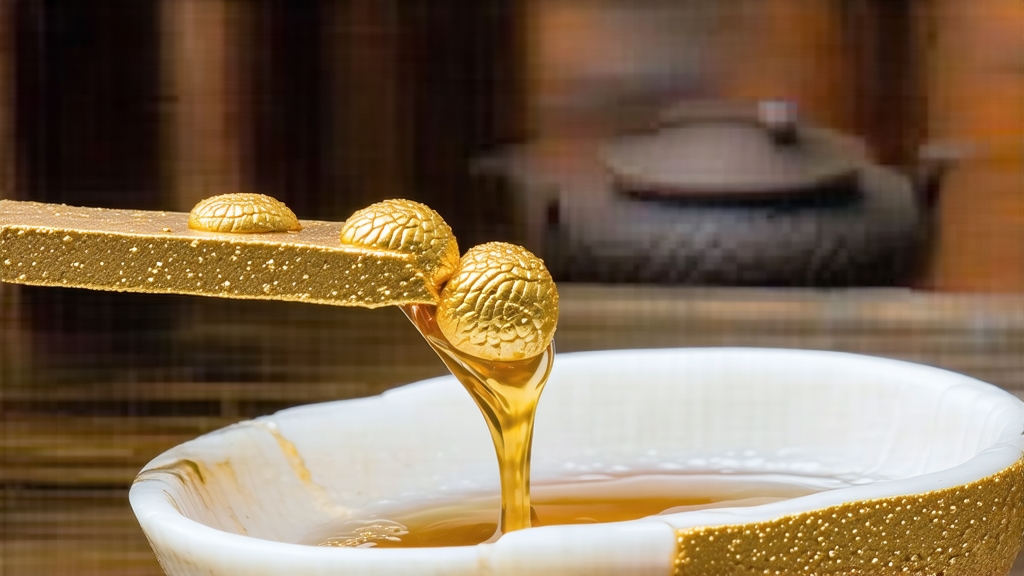
Among the six major chromatic families of Chinese tea, dark tea (heicha) is the only one whose value is measured not by the tenderness of spring buds but by the depth of microbial time. Of its regional clan, none carries a more romantic passport than Fu brick tea—literally “Fu zhuan cha”—a Hunan-born brick that once paid the salaries of frontier garrisons, perfumed the caravans of the Silk Road, and still hides a constellation of golden fungi inside its jet-black body.
-
From Tribute to Currency: A 650-Year-Old Story
The word “Fu” refers to the Ming-era Fu Prefecture (today’s Yiyang City, Hunan), where imperial officers first compressed loose dark tea into standardized bricks in 1368. The new shape cut transport costs along the ancient Tea-Horse Road; more importantly, it created a tamper-proof tax unit. One brick weighed exactly 2.5 kg and bore a government seal—tea became money. Caravans heading west swapped Fu bricks for Tibetan warhorses, Kashgar raisins, even Roman glass beads. By the Qing dynasty the court had institutionalized the “Tea-for-Horse” bureau; annual quotas reached 30,000 bricks, each stamped with a serial number and the reign-year. Thus Fu brick is perhaps the only tea that once enjoyed dual legal tender status: you could both drink it and pay your taxes with it. -
Microbial Alchemy: How Hunan Leaves Become Golden Flowers
Unlike shou Pu-erh that relies on Yunnan’s broad-leaf assamica, Fu brick starts with the hardy sinensis variety grown on the misty foothills of the Xuefeng Mountains. The leaf is purposely coarse; older stems provide the cellulose that feeds the desired microbes. After plucking, the raw material is withered, pan-fired, and rolled in the conventional green-tea manner, but then it is piled 70 cm deep in humid rooms for 12–18 hours to begin “wet-piling” (wo dui). During this half-day sauna the leaf temperature climbs to 55 °C, softening tissues and inviting airborne fungi.
Next comes the step that makes Fu brick unique: brick-pressing while still warm and microbe-laden. The tea is steamed for 30 seconds, tipped into oiled pine boxes, and compressed under 50-ton hydraulic plates for 20 minutes. The resulting brick is wrapped in cotton paper and moved into the “flowering room” (fa hua jian) where temperature is locked at 28 °C and relative humidity at 75 %. Inside this tropical micro-climate Eurotium cristatum—nicknamed “golden flowers” (jin hua)—blooms as tiny yellow dots. After 10–15 days the flowers coalesce into a golden frost; the brick is then dried for a week, slowly dropping moisture to 9 %. No other tea allows a fungus to become its visual hallmark; the more flowers, the higher the grade.
-
Anatomy of a Brick: Grades, Markings, and Secret Codes
Modern Fu bricks are still 2.5 kg, but mini 1 kg and 200 g souvenir sizes abound. The top face carries a relief of characters: “Fu” inside a double-ring, the factory code, and the production year. Insiders read the side-profile: a brick with sharp 90° edges and a tight, slate-like surface indicates proper pressing; a bloated or cracked edge warns of sloppy flowering. Grades are not called “imperial” or “monkey-picked” but simply First, Second, and Third Flower Density. A First Flower brick must display ≥ 900,000 visible colonies per gram; under UV light it fluoresces like a star field. -
The Flavor of Time: What Golden Flowers Actually Do
Eurotium cristatum secretes enzymes that clip long catechins into shorter, less astringent fragments and convert starches into soluble sugars. The result is a liquor that is startlingly smooth—no hint of the rough, smoky character typical of other dark teas. Instead you get damp earth, dried apricot, and a whisper of sandalwood that expands into camphor coolness on the exhale. The aftertaste carries a faint sweetness reminiscent of Tibetan tsampa, a nod to the brick’s historical travel companions. Laboratory tests show a four-fold increase in